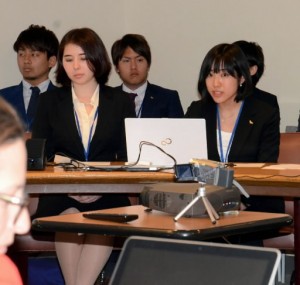A-bomb survivors and students make appeal for nuclear abolition at site of NPT Review Conference
May 13, 2015
by Michiko Tanaka, Staff Writer
NEW YORK--On May 7, atomic bomb survivors and university students from Hiroshima and Nagasaki held a series of events at United Nations headquarters in New York, where the NPT Review Conference is taking place, and conveyed the wish of the A-bombed cities for the abolition of nuclear weapons to the government representatives of member nations and various NGO groups.
The “Nagasaki Youth Delegation,” dispatched by Nagasaki Prefecture, Nagasaki City, and Nagasaki University, explored future directions for nuclear abolition. Twelve university students made speeches based on three themes.
Chisa Nishida, 20, a junior at Nagasaki University, is originally from Nishi Ward, Hiroshima and is a former junior writer for the Chugoku Shimbun. She raised the issue of young people getting involved in peace-related activities, saying, “Current peace education practices don’t touch on global conditions surrounding nuclear weapons. Because of this, many young people are less likely to recognize that nuclear issues are actually problems that impact their own lives. They tend to think that nuclear issues are government decisions that have no connection to them.” Ms. Nishida and other Japanese students asked their counterparts from Western countries for their views and engaged in discussion about strengthening peace education and spreading interest in peace-related issues to those of their generation. They also talked about Japan’s nuclear policy.
Meanwhile, an event called “Raising the Voices of the Hibakusha: The Humanitarian Consequences of Nuclear War” was attended by approximately 50 people. Setsuko Thurlow, 83, a resident of Toronto, Canada, who experienced the atomic bombing of Hiroshima in Higashi Ward, made an appeal for the elimination of nuclear arms by saying, “As long as nuclear weapons exist in the world, there can be no human security.” Clifton Truman Daniel, 57, a resident of Chicago and the grandson of Harry S. Truman, who was the U.S. president at the time of the bombings, told how Sadako Sasaki, who died of A-bomb-induced leukemia 10 years after the Hiroshima attack, folded paper cranes in the hope of recovering from this disease. Mr. Daniel shared his plan to exhibit one of Sadako’s paper cranes, which he received through his contact with members of her family, at the Truman Library in Missouri this November.
(Originally published on May 9, 2015)
NEW YORK--On May 7, atomic bomb survivors and university students from Hiroshima and Nagasaki held a series of events at United Nations headquarters in New York, where the NPT Review Conference is taking place, and conveyed the wish of the A-bombed cities for the abolition of nuclear weapons to the government representatives of member nations and various NGO groups.
The “Nagasaki Youth Delegation,” dispatched by Nagasaki Prefecture, Nagasaki City, and Nagasaki University, explored future directions for nuclear abolition. Twelve university students made speeches based on three themes.
Chisa Nishida, 20, a junior at Nagasaki University, is originally from Nishi Ward, Hiroshima and is a former junior writer for the Chugoku Shimbun. She raised the issue of young people getting involved in peace-related activities, saying, “Current peace education practices don’t touch on global conditions surrounding nuclear weapons. Because of this, many young people are less likely to recognize that nuclear issues are actually problems that impact their own lives. They tend to think that nuclear issues are government decisions that have no connection to them.” Ms. Nishida and other Japanese students asked their counterparts from Western countries for their views and engaged in discussion about strengthening peace education and spreading interest in peace-related issues to those of their generation. They also talked about Japan’s nuclear policy.
Meanwhile, an event called “Raising the Voices of the Hibakusha: The Humanitarian Consequences of Nuclear War” was attended by approximately 50 people. Setsuko Thurlow, 83, a resident of Toronto, Canada, who experienced the atomic bombing of Hiroshima in Higashi Ward, made an appeal for the elimination of nuclear arms by saying, “As long as nuclear weapons exist in the world, there can be no human security.” Clifton Truman Daniel, 57, a resident of Chicago and the grandson of Harry S. Truman, who was the U.S. president at the time of the bombings, told how Sadako Sasaki, who died of A-bomb-induced leukemia 10 years after the Hiroshima attack, folded paper cranes in the hope of recovering from this disease. Mr. Daniel shared his plan to exhibit one of Sadako’s paper cranes, which he received through his contact with members of her family, at the Truman Library in Missouri this November.
(Originally published on May 9, 2015)








